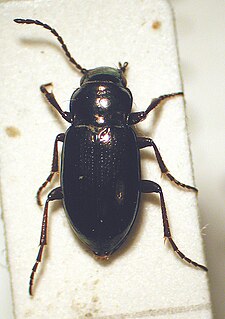
The Trachypachidae are a family of beetles that generally resemble small ground beetles, but that are distinguished by the large coxae of their rearmost legs. There are only six known extant species in the family, with four species of Trachypachus found in northern Eurasia and northern North America, and two species of Systolosoma in Chile. They were much more diverse in the past, with many members belonging to the extinct subfamily Eodromeinae, the first fossils known of this family are of the genera Petrodromeus and Permunda from the Permian-Triassic boundary of Russia.
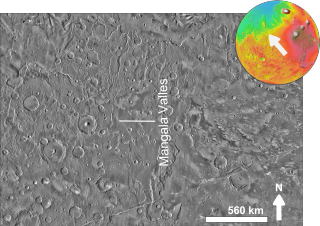
The Mangala Valles are a complex system of criss-crossing channels on Mars, located in the Tharsis region and in the Memnonia quadrangle. They originated in the Hesperian and Amazonian epochs. They are thought to be an outflow channel system, carved by catastrophic floods, and the release of vast quantities of water across the Martian surface. This flooding was probably initiated by tectonic stretching and the formation of a graben, Mangala Fossa, at the channels' head, perhaps breaching a pressurized aquifer trapped beneath a thick "cryosphere" beneath the surface. The Mangala Valles contain several basins; after they filled, the overflow went through a series of spillways. One source of waters for the system was the Memonia Fossae, but water also probably came from a large basin centered at 40 degrees S.

The Memnonia quadrangle is one of a series of 30 quadrangle maps of Mars used by the United States Geological Survey (USGS) Astrogeology Research Program. The Memnonia quadrangle is also referred to as MC-16.

Amblyeleotris is a genus of fish in the family Gobiidae found throughout the Indo-Pacific region. This is the largest genus of the shrimp gobies or prawn gobies, so-called because of their symbiotic relationship with certain alpheid shrimps. The shrimp excavates and maintains a burrow used by both animals while the goby, which has far superior eyesight, acts as a lookout for predators. The shrimp maintains almost constant contact with the fish with an antenna. Fossil Amblyeleotris otoliths have been found together with alpheid shrimp remnants from as early as late early Miocene (Burdigalian) suggesting a possible mutualistic association since then.

Daedalia Planum is a plain on Mars located south of Arsia Mons at 21.8°S 128.0°W and appears to be relatively featureless plain with multiple lava flows and small craters. It is mostly in the Memnonia quadrangle, but parts are in Tharsis quadrangle and Phoenicis Lacus quadrangle. Modern imagery suggests that it may more accurately be called a "fluctus" rather than a "planum".
Memnonia or Memnonium may refer to:

Bernard is a large crater in the Memnonia quadrangle of Mars, located at 23.4° south latitude and 154.2° west longitude. It is 128 km in diameter and was named after P. Bernard, a French atmospheric scientist. The floor of the crater contains large cracks, which may be due to erosion.
Misa is a genus of moths of the family Noctuidae. The genus was erected by Ferdinand Karsch in 1895.

Minio Vallis is an old river valley in the Memnonia quadrangle of Mars, located at 4.3° south latitude and 151.8° west longitude. It is 88 km long and was named after a classical name for river in Italy.

Sabis Vallis is an ancient river valley in the Memnonia quadrangle of Mars, located at 5.3° south latitude and 152.5° west longitude. It is 206 km long and was named after a classical name for the present Sambre River in France and Belgium.
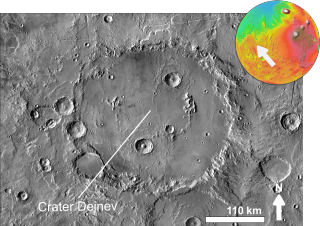
Dejnev is a crater on Mars, located in the Memnonia quadrangle at 25.1° south latitude and 164.8° west longitude. It was named after Russian geographer, explorer, and navigator Semyon Dezhnev (1605–1673). The name was adopted by IAU's Working Group for Planetary System Nomenclature in 1985.
Asopus Vallis is a valley in the Memnonia quadrangle on Mars, located at 4.4° south latitude and 149.7° west longitude. It is 33 km long and was named after a classical name for the modern Boeotian Asopus river in Greece.

Protoparmelia is a genus of lichenized fungi in the family Parmeliaceae. The genus has a widespread distribution, and contains 11 species. Protoparmelia was circumscribed by French lichenologist Maurice Choisy in 1929.
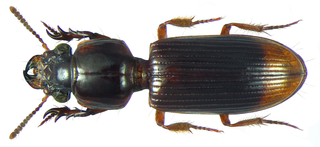
Pseudoclivina is a genus of beetles in the family Carabidae, containing the following species:
Mordellistenoda is a genus of beetles in the family Mordellidae, containing the following species:
Mordellistenoda memnonia is a beetle in the genus Mordellistenoda of the family Mordellidae. It was described in 1997 by Shiyake.

Williams is an impact crater on Mars, located in the Memnonia quadrangle at 18.7°S latitude and 164.3°W longitude. It measures 123.2 kilometres (76.6 mi) in diameter and was named after British astronomer Arthur S. Williams. The name was approved by IAU's Working Group for Planetary System Nomenclature in 1973.

Ejriksson Crater is an impact crater in the Memnonia quadrangle of Mars, located at 19.4°S latitude and 173.9°W longitude. It is 49.0 km in diameter. It was named after the explorer Leif Erikson, and the name was approved in 1967.

Yardangs are common in some regions on Mars, especially in the Medusae Fossae Formation. This formation is found in the Amazonis quadrangle and near the equator. They are formed by the action of wind on sand sized particles; hence they often point in the prevailing direction that the winds were blowing when they were formed. Because they exhibit very few impact craters they are believed to be relatively young. The easily eroded nature of the Medusae Fossae Formation suggests that it is composed of weakly cemented particles, and was most likely formed by the deposition of wind-blown dust or volcanic ash. Yardangs are parts of rock that have been sand blasted into long, skinny ridges by bouncing sand particles blowing in the wind. Layers are seen in parts of the formation. A resistant caprock on the top of yardangs has been observed in Viking, Mars Global Surveyor, and HiRISE photos. Images from spacecraft show that they have different degrees of hardness probably because of significant variations in the physical properties, composition, particle size, and/or cementation.
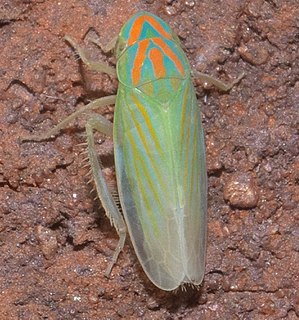
Hecalini is a tribe of leafhoppers in the family Cicadellidae. There are about 24 genera and over 180 described species divided into two subtribes in Hecalini.














